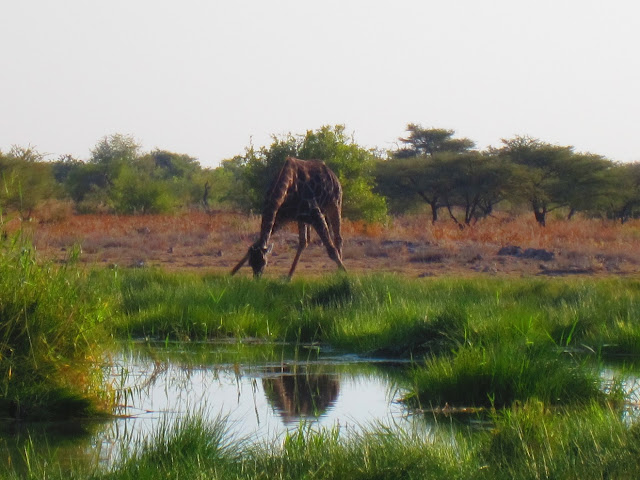Most of you might know it already: We got robbed and that means all stories & pictures between Etosha and Okavango Delta that I had on my laptop and camera are gone. Until we solved our passport and money issues we won't be able to post in this blog. Keep your fingers crossed that it won't take too long.
This is how it happened:
After a long drive from Maun across Botswana to the eastern border we wanted to stay overnight close to the Zimbabwean border to be the first ones to cross the next morning. Unfortunately campsites were scarce on that side of the country so we tried our luck at a lodge. The manager was a really friendly guy and after a short chat he offered us to stay in one of the cottages on the property for very little money as they had a last minute cancellation. We couldn't believe our luck! After 3 weeks of camping a luxurious cottage overlooking a lake with a huge bed, hot shower and TV was just what we were craving for. We packed all our valuables from the car into the lounge room of that cottage and connected everything (laptop, camera, battery pack, electric razor) to the power station because who knows when is the next opportunity.
We went to bed and slept deeply because the mattress was sooo soft and comfy. ..
The next morning I got up, went through the lounge room into the shower, came out and tried to find my jeans which I just left hanging over a chair the night before. And only after minutes of pondering and searching, I realized the whole disaster: EVERYTHING from the lounge room was gone!!!
Not only the laptop, the camera, the battery pack, the razor... also all available cables, my handbag incl. all travel documents, John's backpack with important things in, his harddrive with documents, our clothes, sunglasses, watch, binoculars. ..
And the doors were still locked!
What a nightmare!
After the manager and the police came over we realized they must have come through the window, which were open due to the installed mozzie net.
There is no way we could have thought of that. Even the police considered the place safe. The thieves must have known the place.
The manager immediately sent out his whole staff to screen the huge property for anything the thieves might have chucked on the way. The police came with a bloodhound who followed a trace. But only 4 km from the cottage is the Zimbabwean green border, so the police had no authority to follow the trace any further. The staff however risked their life and safety for finding our things. Okay, the manager has set a nice incentive of 1000Pula ( almost a month's salary) for the one who brings the passports.
The whole morning we were busy with the police, answering their questions (how much do you think the jeans was worth...), they even took fingerprints from the window. We could use the manager's office to manage some issues online, they fed us breakfast and offered free accommodation until we have sorted out everything.
In the afternoon we drove to the police station (luckily the car keys were dropped next to the car and they hadn't opened it), picked up our police reports ( a story in itself I can tell you) and went back to learn that the guys found something 20km into Zimbabwe, which was my (already cancelled) credit card and driver's licence. But that's it. We waited for them to come back to the lodge but they hadn't found anything else.
Of course many "if only's" go through our head. We were lucky enough to have had both our phones next to our bed. The thought of having thieves just behind a thin wall next to you while you are peacefully sleeping is horribly creepy. But honestly, who wouldn't have left his things in the lounge room on a guarded private property? Yes, we learned our lesson, however we were always aware of the fact that we are in AFRICA and we always took security seriously. But there is always this one moment when you feel a little safer, that's when it hits you...
As it is not much fun typing stories with one finger on the smartphone you guys have to wait until I get a new laptop which can't happen before my new credit card arrives in Africa...
And no, we will not cancel the rest of our travels! As soon as the embassy lets us we'll continue traveling... a dream is a dream.



